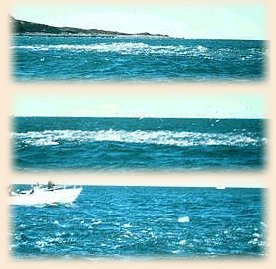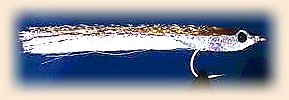I live on the North shore of Long Island Sound and fish the waters east of
New York to Cape Cod. New England produces a wide variety of salt-water game
fish throughout the year. The fly fishing can be unbelievable at different
times of the year. The reason we have such a fine fishery is the immense
schools of baitfish; Atlantic Sandeels, Bay Anchovy, Spearing and larger
baits such as Smelt, Herring and Menhaden. These baitfish procreate in our
rivers, bays and estuaries, supplying game fish with hardy meals throughout
the year. I can't imagine a seventy-five foot cast with a three-pound
menhaden at the end of your tippet; so we'll leave the larger baits for the
meat fishermen and concentrate on the smaller fry which are the major food
source anyway.
In early spring, Sand eels move into beaches, rivers and estuaries along the
coast preferring areas with sandy bottoms. They provide food for hold over
bass and early Bluefish. In late spring Silver sides or Spearing are in
abundance, followed by large schools of migratory Striped Bass and Bluefish
that invade our coastline. By early summer Bay Anchovies are everywhere; they
are the major food source until they head for deeper water in late November.
By late summer Bay Anchovies are approximately two to five inches in length.
Large schools of these fish can be found in the mouths of rivers, estuaries,
bays and harbors.

Late summer to mid November is an unbelievable time for flyrodders, fom the
inlets of Martha's Vineyard to the rips and shoals off Block Island, along
the beaches of Montauk Point to the reefs of Watch Hill Rhode Island. Large
schools of Bonito, False Albacore, Striped Bass and Bluefish prey on large
schools of Anchovy in open water. Large schools of Anchovy, packed tightly
together in large balls, look like hot air balloons suspended in the water,
driven up and down the beaches. Bluefish and Striped Bass attack these balls
of bait, driving thousands of Anchovy into the air. Once airborne they fall
prey to hundreds of seabirds hovering over these schools. Albacore and Bonito
often strafe the outer edges of these schools adding to the mass confusion.
These fish are truly horsepower with fins, blink your eyes they are here,
gone and back again.
I don't know any other sound that will make a flyrodder's heart skip a beat
than the sound of these Anchovy leaving the water like a shockwave down the
beach. It is not uncommon to fish these schools and catch numerous Bass,
Blues, Albacore and Bonito in one day.
When fishing extremely heavy schools of bait, you need a fly which matches
the bait but stands out from the rest. One thing these baits all have in
common is they flash. In large schools these fish dart, turn and leap out of
the water when pursued by larger fish. Sunlight strikes their silvery sides
and reflects back a flashy, shimmering effect in the water. For as long as I
can remember, spin fishermen have used spoons which produce good catches. To
me a spoon doesn't resemble a baitfish, but suggests the flash of a fleeing
one.

I've spent a lot of time at the tying bench and have come up with a pattern
which is easy to tie. It resembles a Bay Anchovy and has a flashy underside.
Local fishermen and myself have fished this pattern for Striped Bass and
Bluefish successfully throughout the year. This fly also produces Albacore
and Bonito on days when these fish can be frustrating.
For the Flashy Anchovy click here.
~ Bob
About Bob:
Bob is a USCG Licensed Captain and fly-fishing guide from Stratford
CT, and owner of North Coast Charters, just 45 minutes from
New York City. He specializes in saltwater Fly and Light
Tackle Charters. He fishes coastal Connecticut and Southern
Rhode Island for Striped Bass, Bluefish, Bonito and False
Albacore. You can reach him at (203) 378-1160.
|



